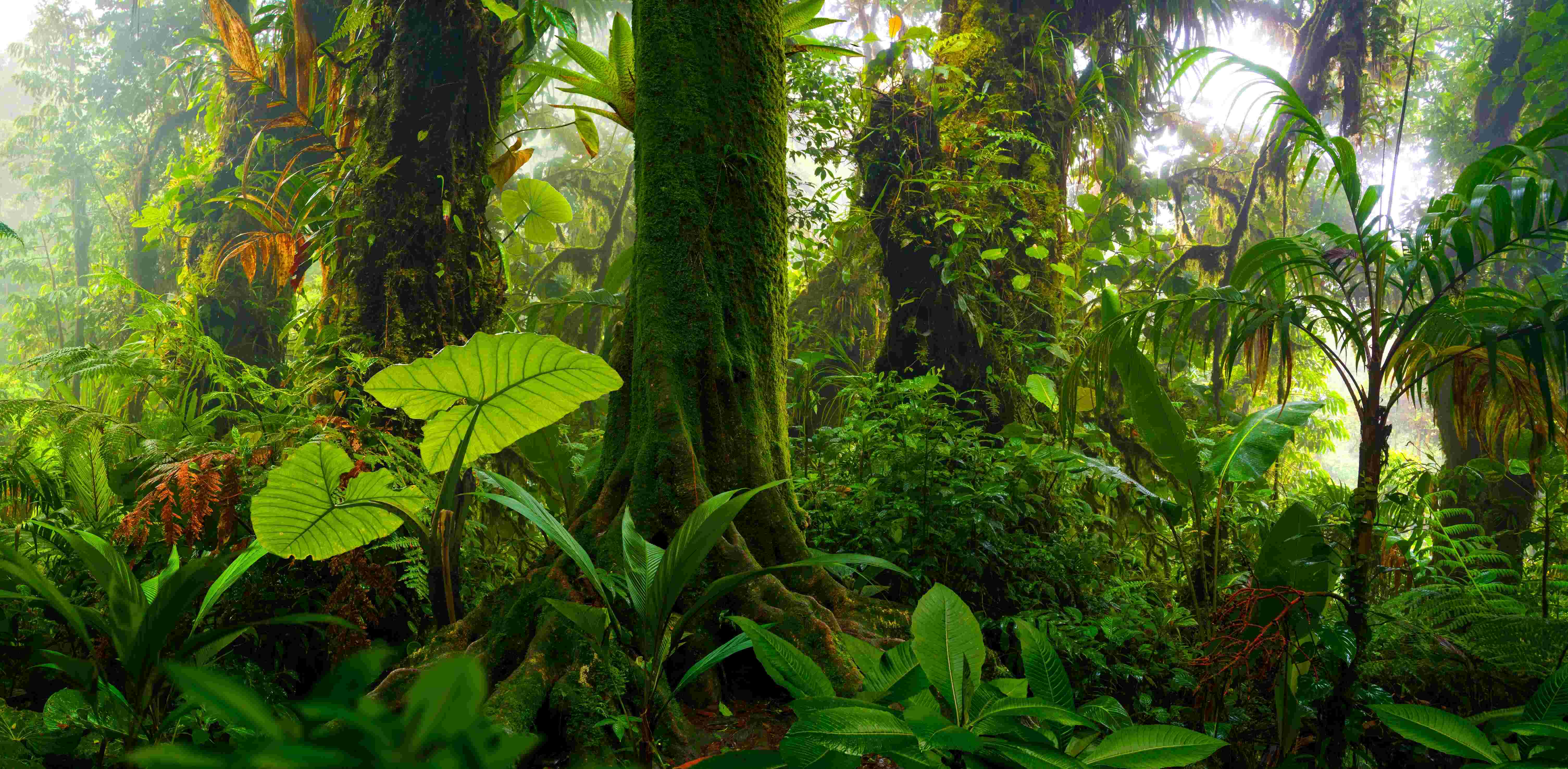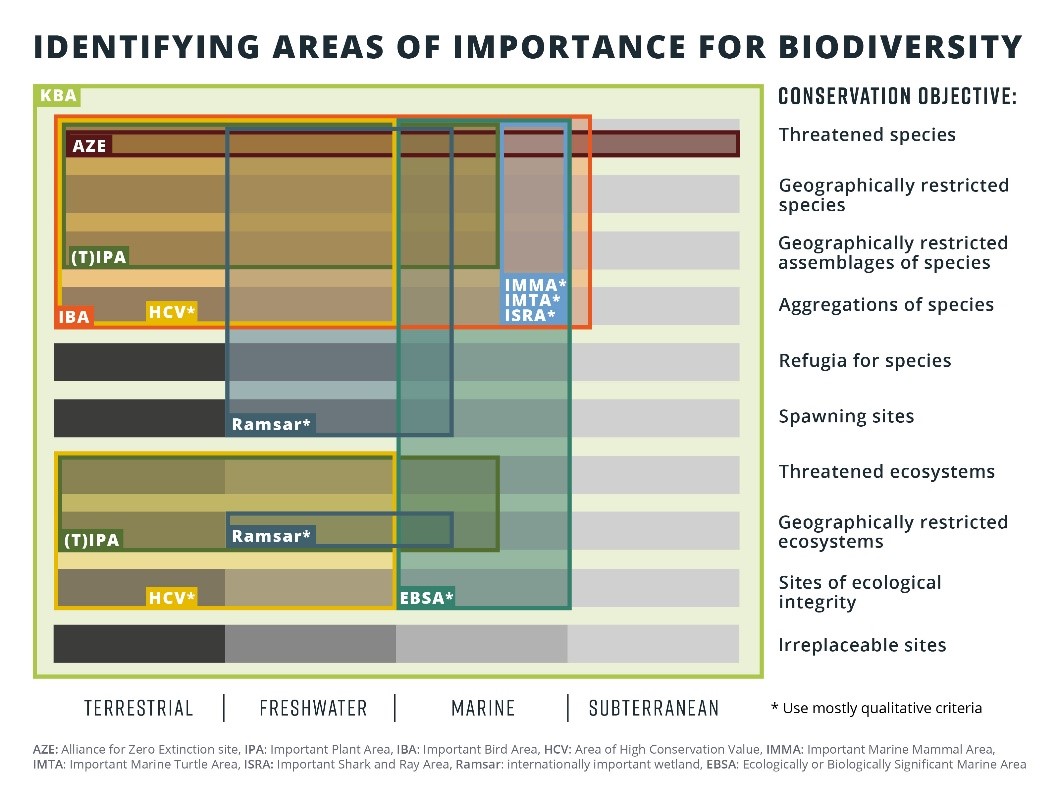The criteria used to identify KBAs focus on particular biodiversity features: globally threatened species and ecosystems; geographically restricted species, species assemblages and ecosystems; sites of outstanding ecological integrity; biological processes; and irreplaceability (Figure 1). KBA status is based on threshold amounts of the global population of a species, global extent of an ecosystem, or most intact sites within an ecoregion. For example, for a site to qualify as a global KBA for a geographically restricted species it needs 10% threshold or more of the species global population at a site; for a critically endangered species only 0.5% of the global population at a site is needed to trigger KBA status; and for an endangered ecosystem 5% of the global extent of the ecosystem is needed at a site to meet KBA status. They therefore identify sites that are globally significant for nature, and their protection and conservation will contribute to halting and reversing the loss of species or ecosystems.
We recognise that ecological connectivity between important sites is also important for biodiversity persistence. Assessing the globally significant populations and ecosystems in KBAs that need to be connected to maintain viability is one way in which KBAs can be used to prioritise where connectivity needs to be maintained or enhanced.
For the purposes of the GBF, we propose harnessing the KBA criteria such that areas of particular importance for biodiversity are defined as: Sites that contain significant populations/extents of threatened or geographically restricted species or ecosystems, or that have significant ecological integrity or irreplaceability, are significant for the maintenance of biological processes, or provide significant ecological connectivity to maintain the broader viability of KBAs. Significance is defined by a site exceeding a quantitative threshold of the global distribution of the biodiversity feature supported.
Systematic Conservation Planning (SCP) approaches are likely to be used for many of the spatial plans developed for Target 1. These employ analytical tools and software to identify sites for conservation that aim to minimise the area needed by considering ‘complementarity’ between potential areas to include. In SCP the species, ecosystems, and conservation objectives need to be identified and applied. Incorporating areas meeting the definition would strengthen any SCP output.
Even in South Africa, which has one of the most comprehensive plans for biodiversity conservation of any country, a recent assessment of KBAs identified sites (particularly for geographically restricted but non-threatened biodiversity) that were missing, but are now being incorporated into a revised national conservation plan. Countries such as Canada, Mozambique, Gabon, Republic of Congo, Democratic Republic of Congo, Uganda, Ecuador, Bolivia, Colombia, and Peru are all working on making comprehensive assessments of their KBAs to guide their biodiversity conservation action. Mozambique completed the first comprehensive assessment in 2021 and have incorporated their KBAs in the National Territorial Plan that guides government supported development and plan to use a new offset law to support the financing of these sites.
There are only seven years remaining for the implementation of the GBF, and it is critical that countries start identifying where they will conserve to achieve their contribution to protecting and conserving 30% of the world by 2030, as well as determining which important sites for nature should be incorporated into their spatial plans. To halt and reverse the tide of biodiversity loss, we have to agree and apply a definition for areas of particular importance for biodiversity that ensures all conservation objectives are met. Our proposed definition aims to achieve this.






Significance of biodiversity conservation in our lovely land Mal
I wish to commend that everyone has to indeed embrace the culture of conserving biodiversity at local level. This will help to conserve other endangered species and also curb the adverse impacts of climate change that we are currently facing globally. If possible would you please consider our country (Malawi) to be part of your target country since this is beneficial to our country too.
Kindly regards
Biodiversity
Surely, if there is a biodiversity crisis due to rapid decline of many species, including insects, birds, trees and sealife, we cannot cherry-pick and decide on the merits of one area against another. All biodiversity needs protecting and enhancing so that nature can thrive and recover. We would be better off addressing the causes of the decline and targeting those e.g. deforestation, plastic/chemical pollution in our oceans, farming and use of pesticides, housing development, light pollution
Area in Colombia
My family owns a land in Colombia 1 hour away from Medellin.(34 Ha.) I have tried to find sponsorship for returning the land to native woodland with no response. It this something you could help with?
michaelbuff3@gmail.com
KBA
I wonder if there would be a way when selecting KBAs or other criterion that it could in some way incorporate a MP (or something similar)? Maybe a two step process, select KBA site using your new definition and step 2 devise a MP to protect this site long term. Otherwise we select KBA sites and then what?
KBAs in SIDS
I see that no SIDS country is mentioned on developing actions to include/consider kBAs in their conservation action plans. We are at a good time to promote this among SIDS countries, In the case of insular Caribbean the Caribbean Ecosystems Partnership Fund promotes conservation actions in relation to KBAs, but we need to promote more the formal inclusion in national GBF related strategies.
Canned hunts propertiesand trophy hunting in unprotected areas
All true conservationists understand that those practices have a huge negative evasive impact on wildlife. We are not even talking about the top 5 in Africa. Pangolins, red wolves, sea horses, panthers and many more fall victims everyday to private interests.
I know that stopp8ng that massive impact on wildl7f3 seems to difficult to deal with. Yet, meant measures should be put in place, to start dealing with what I call a disease based on personal gain & greed.Roadside zoos should never be legal
Add new comment